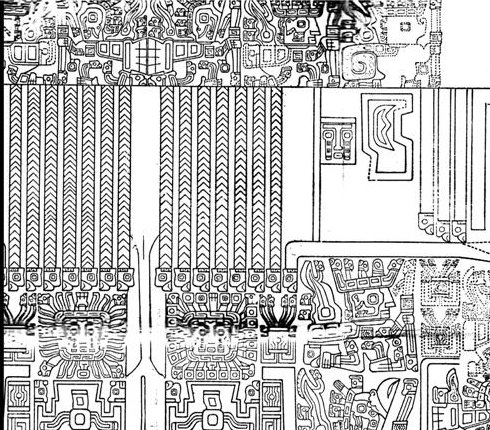In rongorongo times κ Virginis rose heliacally 214 days after March 21 and Syrma rose with the Sun in the following day. This appears to be engraved in stone where the tresses of Pachamama are divided in right and left:

|
Counting the tresses from right to left: |
|
1 |
27 |
8 |
29 |
|
2 |
26 |
9 |
30.5 |
|
3 |
26.5 |
10 |
31 |
|
4 |
26.5 |
11 |
34 |
|
5 |
26.5 |
12 |
31 |
|
6 |
27 |
13 |
30 |
|
7 |
26 |
14 |
29 |
|
Sum |
185.5 |
Sum |
214.5 |
|
Total = 400 |
|
(27 + 26) + (29 + 29) = 111 |
The back side of Pachamama should be understood as her night side and therefore we ought to compare with the 'text serpent' on side b, the back side, of the Mamari tablet. The tresses of Pachamama are hanging straight down without any sign of life and the times of Al Sharatain were in the past (at the back).
In the times of Al Sharatain we can assume the March equinox was in day 25 - because such had been decided by Julius Caesar. In the night of 'March 25 the stars at the 'door' in Virgo (κ and Spica) could be seen close to the Full Moon.
| 'March 25 |
26 (85) |
27 (452) |
rutua - te pahu - rutua te maeva - atua rerorero - atua hiko ura - hiko o tea - ka higa te ao ko te henua ra ma te hoi atua |
| 'September 24 |
25 (268) |
26 |
| April 21 (111) |
22 (478) |
23 |
| October 21 |
22 (295) |
23 |
 |
 |
 |
| Cb1-5 |
Cb1-6 |
Cb1-7 (399) |
| η Arietis (31.9) |
no star listed (32) |
θ Arietis (33.3), Mira (33.7) |
| Neck-2 |
Al Ghafr-13 / Svāti-15 |
ι Lupi, 18 Bootis (216.3), Khambalia (216.4), υ Virginis (216.5), ψ Centauri (216.6), ε Apodis (216.8) |
| Asellus Tertius, κ VIRGINIS, 14 Bootis (214.8) |
15 Bootis (215.2), ARCTURUS (215.4), Asellus Secundus (215.5), SYRMA, λ Bootis (215.6), η Apodis (215.8) |
| 'March 28 |
29 |
30 (455) |
31 (90) |
| 'September 27 |
28 |
29 |
30 (273) |
| April 24 |
25 |
26 (116) |
27 |
| October 24 |
25 |
26 |
27 (300) |
 |
 |
 |
 |
| Cb1-8 |
Cb1-9 |
Cb1-10 |
Cb1-11 (403) |
| no star listed (34) |
ξ Arietis (35.0) |
no star listed (36) |
no star listed (37) |
| Asellus Primus (217.8) |
τ Lupi (218.1), φ Virginis (218.7)
Fomalhaut
|
σ Lupi (219.1), ρ Bootis (219.5), Haris (219.7) |
σ Bootis (220.2), η Centauri (220.4) |
In rongorongo times these nakshatra stars had advanced 27 days from 'March 25 (84) to April 21 (111) due to the precession and the extraordinary week beginning here can be interpreted as evidence we ought to read this week from a nakshatra view. The bird in Cb1-11 has a closed beak.
I guess the drums could have been sounding (rutua - te pahu) because in the text the stars were moving (rutua te maeva) - as if by an 'Earth-quake' (ru) - shifting the view from the present time (side a) to the back side (tua).
| Ru A chill, to shiver, to shudder, to quake; manava ru, groan. Ruru, fever, chill, to shiver, to shake, to tremble, to quiver, to vibrate, commotion, to apprehend, moved, to agitate, to strike the water, to print; manava ruru, alarm; rima ruru, to shake hands. P Pau.: ruru, to shake, to tremble. Mgv.: ru, to shiver with cold, to shake with fever, to tremble. Mq.: ú, to tremble, to quiver. Ta.: ruru, to tremble. Churchill.
Mgv.: eager, in haste, impatient. Ta.: ru, impatience, haste. Churchill.
Ruru, to tremble, an earthquake. Sa.: lūlū, lue, to shake. To.: luelue, to roll; lulu, to shake. Fu.: lulū, to tremble, to shake, to agitate. Niuē: luelue, to shake; lūlū, to shake, to be shaken. Nuguria: ruhe, motion of the hands in dancing; luhe henua, an earthquake. Uvea, Ha.: lu, lulu, lululu, to shake, to tremble, to flap. Fotuna: no-ruruia, to shake. Ma.: ru, ruru, to shake, an earthquake. Ta., Rarotonga, Rapanui, Pau.: ruru, to shake, to tremble. Mgv.: ru, to tremble; ruru, to shake. Mq.: uu, to shake the head in negation; uuuu, to shake up. Uvea: ue i, to shake; ueue, to move. Rapanui: ueue, to shake. Churchill 2. |
|
Tua 1. Back, shoulder, tu'a ivi, shoulder
blade; tu'a ivi more, lumbago; moa tu'a ivi raá,
'sun-back chicken': chicken with a yellow back which shines in the
sun. 2. Behind (a locative adverb, used with i, ki, a, o,
etc). Tu'a-papa, pelvis, hips. Vanaga.
1. Behind, back, rear; ki tua, after; o
tua, younger; taki tua, perineum. 2. Sea urchin, echinus.
The word must have a germ sense indicating something spinous which
will be satisfactorily descriptive of the sea urchin all spines, the
prawn with antennae and thin long legs, and in the Maori the shell
of Mesodesma spissa. Tuaapapa, haunch, hip, spine.
Tuahaigoigo, tattooing on the back. Tuahuri, abortion;
poki tuahuri, abortive child. Tuaivi, spine, vertebræ,
back, loins; mate mai te tuaivi,
ill at ease. Tuakana,
elder, elder brother; tuakana tamaahina,
elder sister. Tuamouga,
mountain summit. Tuatua,
to glean. Mgv. tua: To fell, to cut down. Ta.: tua,
to cut. Mq.: tua, to fell, to cut down. Ma.: tua, id.
Tuaki, to disembowel. Ma.: tuaki, to clean fish.
Tuavera, the last breadfruit spoiled by the wind. Ta.:
tuavera, burnt by the sun. Churchill. |
| Maeva T. 1. Move. Rangi-maeva = Moving Sky (name of a marae). 2. Greet, greeting. Henry. |
|







